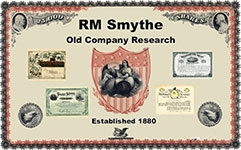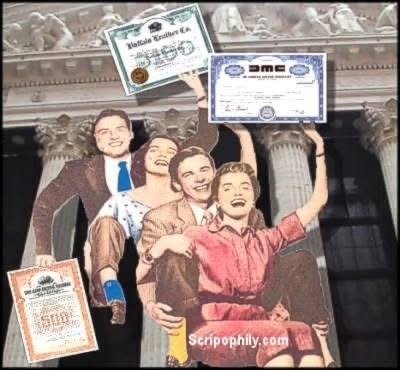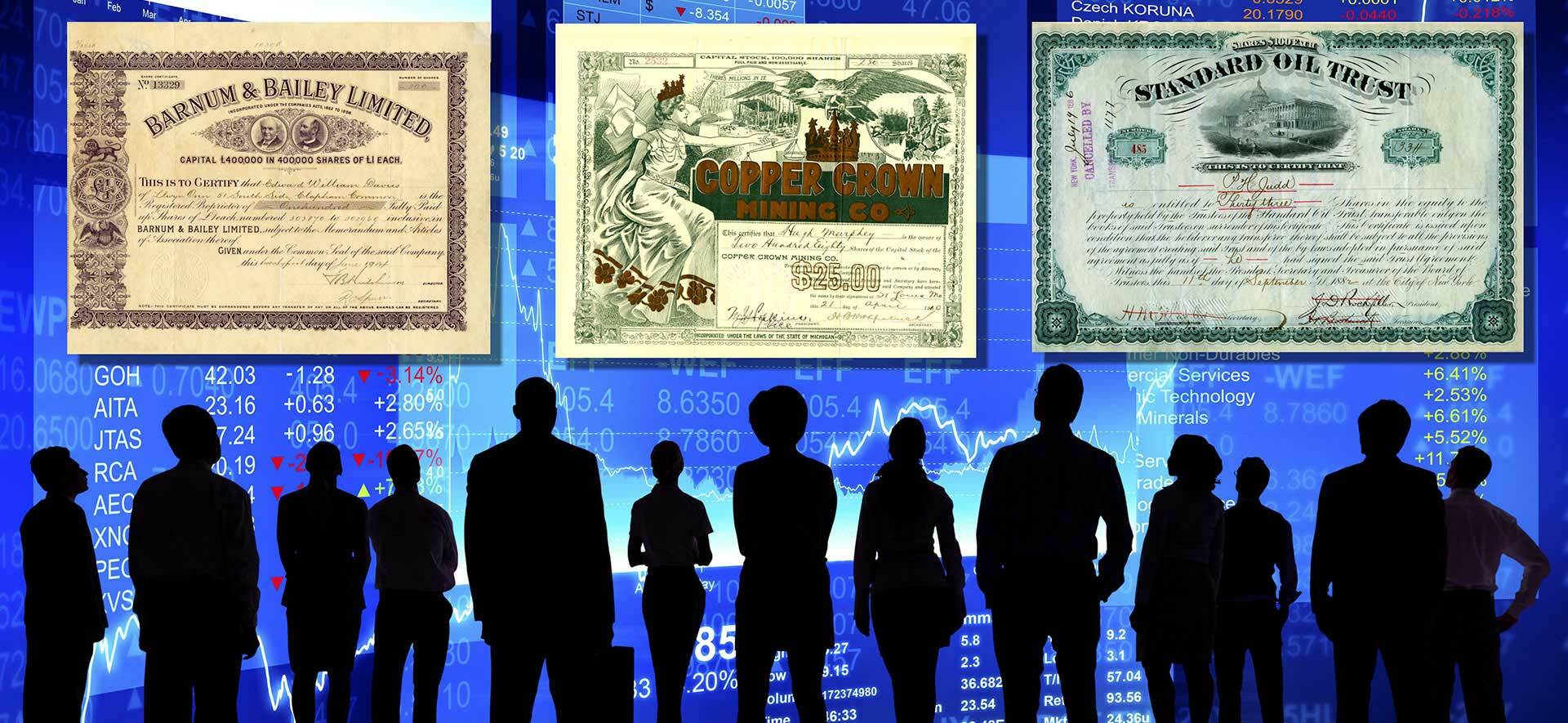Beautifully engraved unissued Certificate from the Brush Electric Light & Power Company dated 188_. This historic document has an ornate border around it with a vignette of the Cleveland Manufacturing facility. This item is over 111 years old. Wabash was the first city to be lit solely by electricity and to own its own municipal power plant (that small dynamo driven by a threshing machine engine). The installation in Cleveland the year before in 1879 had been a demonstration, but Cleveland would soon begin lighting its streets with arc lamps as well. In 1876 Charles F. Brush invented a new type of simple, reliable, self-regulating arc lamp, as well as a new dynamo designed to power it. Earlier attempts at self regulation had often depended on complex clockwork mechanisms that, among other things, could not automatically re-strike an arc if there were an interruption in power. The simpler Brush design used a solenoid combined with a clutch mechanism to adjust the carbons over their entire length. Combined with improvements like an automatic shunt coil to remove a failed lamp from the main circuit, double carbons which could burn all night, and plated carbons for improved conductivity, this lamp/dynamo system made central station lighting a possibility for the first time. In the late 1870's small Brush arc lamp installations were being purchased by individuals, department stores, theaters, and factories. 1880 saw the first larger scale commercial use of arc lamps for street lighting as Brush plants, and eventually those of competitors like Thomson-Houston, were established in a number of large cities throughout the US. The letterhead at the top of this page is from a bill from a local Brush utility to the City of New York for street lighting. In 1880 Brush successfully demonstrated arc lighting along Broadway, and soon thereafter built New York's first central station. Similar systems were installed all over the world. In 1889 the Brush Electric Company was purchased by the Thomson-Houston company, which then merged with the Edison Electric Company in 1892 to form the General Electric Company. GE and others continued manufacturing arc lamps for decades despite the predominance of incandescents. Arc lamps were simply much brighter, and better suited to certain applications. Charles Francis Brush was an American pioneer in the commercial development of electricity. His inventive genius ranked with an elite group of electric pioneers including Thomas A. Edison. Brush designed and developed an electric arc lighting system that was adopted throughout the United States and abroad during the 1880's. The arc light preceded Edison's incandescent light bulb in commercial use and was suited to applications where a bright light was needed, such as street lights and lighting in commercial and public buildings. A key element in Brush's arc lighting system was his dynamo (electric generator). The dynamo was the workhorse of the Central (power) Station, a concept developed independently by Brush and Edison, which eventually grew into the electric power generating industry. Brush was born on his parents' farm March 17, 1849. His early years were spent on the Walnut Hills Farm, about 10 miles east of Cleveland. He was not a typical farm boy and developed an interest in science and electricity at an early age. "He spent as much time in a small workshop in the house as he did at the chores of the farm. As a boy, he was more excited about Humphrey Davy's experiments with the arc light than he was about the success of the farm at Walnut Hill."1 At the age of 12, Brush built his first static electric machine. Utilizing materials at hand on the farm, Brush experimented with electricity and constructed a number of electrical devices. Brush's parents realized that Charles would benefit greatly from a good education and they made the financial sacrifice to send him to Cleveland's Central High School. It was there that Brush fulfilled his boyhood dream of constructing an arc light. He graduated from Central High in 1867 with honors. Isaac Brush did not have the financial means to support a college education for his son. An uncle of Charles' from his mother's side of the family provided a loan which enabled him to continue his education and he enrolled at the University of Michigan in the fall of 1867. At the time, the University of Michigan did not have a course of study in electricity and Brush chose mining engineering as his major, a field he felt would give him practical training for a career. It also developed his knowledge in science, which would prove valuable for his experimentation with electricity which would soon follow. Brush graduated from the University of Michigan in June, 1869 at the age of twenty. He had worked hard to finish his course of study in a short time, working through the summer months to accelerate his rate of progress. Repayment of the debt to his uncle was part of the motivation for his fast track approach, reasoning that an early graduation would mean earlier employment and resolution of the debt. After graduation Brush returned to Cleveland where he established himself as an analytical and consulting chemist. This endeavor did not prove to be very profitable and in 1873 he joined forces with a boyhood friend, Charles Bingham, to market Lake Superior pig iron and iron ore. It was during this time that he became reacquainted with another boyhood friend, George Stockly, vice president and general manager of the Telegraph Supply Company of Cleveland. Brush related some of his early experimentation with electricity to Stockly and discussed his vision for the development of arc lighting. The lighting system would need an efficient means of generating electricity, which Brush proposed to do by using a dynamo. Stockly was very impressed with Brush and his ideas and agreed to financially support his effort to construct a small dynamo. The Telegraph Supply Company provided material and facilities needed for preliminary development work. The initial work on the dynamo was done by Brush on a part-time basis, working after hours while continuing with his sales activity in iron ore. In 1877 Brush quit the iron ore business and devoted his full attention to the dynamo. He assembled his first dynamo in the summer of 1876 while "vacationing" at his old home, Walnut Hills Farm. Brush used a horse-drawn treadmill to power the dynamo and was able to generate electricity with his new machine. He returned to the Telegraph Supply Company later that summer to continue development work. These early efforts resulted in U.S. Patent No. 189 997, "Improvement in Magneto-Electric Machines", issued April 24, 1877. The dynamo provided an economic and efficient source of electricity for the arc light and this was a key factor in developing a commercially viable system of lighting. With a functional dynamo in hand, Brush turned next to developing an arc lamp while simultaneously continuing with development of the dynamo. The arc light was not a new idea but those in existence at the time were not very practical. The chief drawback in lamps was the lack of a good regulating system for the carbon electrodes. As an arc light operates, the electrodes are consumed at their tips, where the electric arc occurs. Extended operation of the lamp requires the maintenance of a specific gap between the electrodes, which can be effected by moving the electrodes during operation with a regulating device. The poor regulation of existing arc lamps resulted in variable light output and unreliable operation. Brush developed an arc light that was regulated by a combination of electrical and mechanical means. The elegant design, as often is the case, was simple and easy to maintain. An electromagnet was used via a mechanical linkage to move the upper carbon electrode. However, the movement was modulated and limited by a "ring clutch". In hindsight one might think a simple design solution could be conceived quickly; but simple designs are not always obvious until the inventor is successful. Brush's clever design was perfected after a considerable amount of time in the laboratory. There were other arc lamps before Brush's that utilized electromagnets as part of a regulation system but it was the combination of the electromagnet with the ring clutch that made Brush's design superior in regulating the arc. Brush's lamps featured other design improvements including copper plated electrodes, regulators for operation of multiple lamps connected in series to one dynamo, and double carbon arc lamps for extended operation. Brush installed his first commercial arc lamp on the balcony of a doctor's residence in Cincinnati in 1878. A number of indoor installations soon followed. He was keen to develop further outdoor lighting, an application eminently suited to the power of the arc light. These would be public lighting systems that would replace the gas lamp. At the time the average citizen knew very little about electricity and had no appreciation for its potential as a power source. Brush needed some way to demonstrate the power of his arc lamp to the public. This he did on Cleveland's Public Square, then known as Monumental Park, on April 29, 1879. Twelve arc lamps were positioned around the park and they were powered in series by a dynamo housed in the Telegraph Supply Company nearby. A news article in the Plain Dealer described the occasion: At five minutes before eight o'clock there was a flicker in the lamp nearest the Telegraph Supply Company's headquarters and immediately the twelve lights beamed forth from their various stations. The lamp posts are much higher than the gas posts, making the electric lamps like beacon lights. Thousands of people gathered to witness the scene and as the light shot around and through the Park a shout was raised. Presently the Grays Band struck up in the Pavilion and soon afterward a section of artillery on the lake shore began firing a salute in honor of the occasion. The light varied some in intensity at intervals, when shining brightest being so dazzling as to be painful to the eyes to look long at a lamp. In color it is of a purplish hue, not unlike moonlight, and by contrast making the gaslights in the store windows look a reddish yellow. Some people had raised their expectations too high and were disappointed because it was not as light as day but most people seemed struck with admiration, both by the novelty and brilliancy of the scene. The reaction of the crowd must have been pleasing to Brush and confirmed his vision of the utility of the arc light. Soon cities across America would place orders for the Brush arc lights, and his name became known to many. Before the end of 1881 Brush arc light systems were illuminating the streets of New York, Boston, Philadelphia, Baltimore, Montreal, Buffalo, San Francisco and other cities.2 In order to keep pace with the rapidly increasing demand for Brush lighting systems, the Telegraph Supply Company of Cleveland underwent significant restructuring, giving birth to the Brush Electric Company in the summer of 1880. The new company constructed a 200,000 square foot factory located between Belden and McHenry streets at their intersection with Mason St. This new facility would thrive for a short time in the 1880's before it was closed due to the merging of Brush Electric with competitor Thompson-Houston Electric Company in 1889 and in turn with the Edison General Electric Company in 1891 to form the General Electric Company still known by the same name today. These mergers marked Brush's exit from the emerging electrical industry. He sold his interest in Brush Electric and moved on to other fields of endeavor, never to return to the electric industry. Nevertheless, his innovations were an essential part of the development of electricity for commercial use. The arc light made Brush a wealthy man. In 1884 he moved to his famous mansion, located on Euclid Ave. at East 37th Street. The new home included a laboratory in the basement and a large windmill in the backyard used to generate electricity for the house. His was a story of a self-made man, who elevated himself from humble beginnings on a farm near Wickliffe, Ohio, to a prominent citizen of the Cleveland community. See http://www.voltnet.com/arclamps/brush.html for more information about this great man.
Brush Electric Light & Power Company - Montana Territory 1880's - Early General Electric Company
MSRP:
$89.95
$29.95
(You save
$60.00
)
- SKU:
- bruselligpow
- Gift wrapping:
- Options available in Checkout










